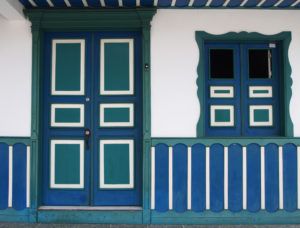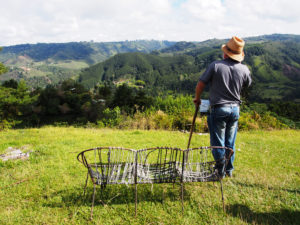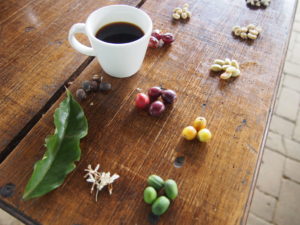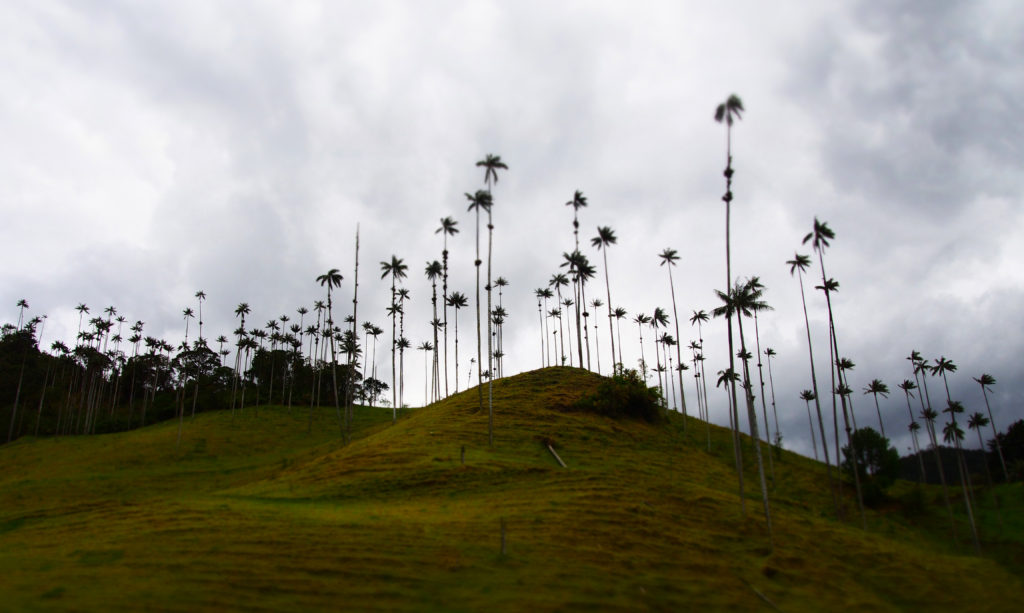Salento is a day’s bus travel west of Bogota. It is in the coffee triangle and unsurprisingly known for coffee, but also, perhaps surprisingly for the crazy tall Palm trees.
Salento Town
 The town is Salento is quite small, with its main plaza perched on a hilltop.
The town is Salento is quite small, with its main plaza perched on a hilltop.
Everywhere you look the city oozes character and charm. The buildings are painted in bright and beautiful colour combinations. The town is busy, but relaxed with a positive vibe.
The aroma of coffee wafts into the streets from the numerous cafes, as the air is filled with chatter and laughter.
Tejo
 One of the things to do in Salento is play the local game of Tejo. We played at a bar called Los Amigos, where the cost of playing is free (or next to nothing) while you are drinking.
One of the things to do in Salento is play the local game of Tejo. We played at a bar called Los Amigos, where the cost of playing is free (or next to nothing) while you are drinking.
The game is played in aisles. At the end of the aisle is a mud pit containing a metal ring. Five small sachets of gun powder are placed on the ring. Standing at least two to three metres from the mud pit, you throw a metal weight at the pit, with the aim of exploding the gun powder. If your weight lands in the center of the ring and explodes all five sachets, you earn 9 points; if your weight lands in the centre of the ring it is 6 points; and an explosion is 3 points. Any of these things will finish the round. If none of these things occur, one point goes to the player whose weight is closest to the ring. The first person/team to achieve 21 points wins. It’s loads of fun!!!
Don Eduardo’s Coffee Tour
Cost: 30,000 pesos.
 Tim Edwards, the owner of our accommodation, The Plantation House owns a small coffee plantation and offers plantation tours. (Guests received a reduced tour cost, we stayed two nights and paid half the cost)
Tim Edwards, the owner of our accommodation, The Plantation House owns a small coffee plantation and offers plantation tours. (Guests received a reduced tour cost, we stayed two nights and paid half the cost)
Tim does a brilliant job of explaining the different types of coffee in the world. The Robusta which originated in West Africa, has less flavour but more caffeine; and the Arabica having originated in Ethiopia, has more flavour and less caffeine.
Arabica coffee is grown between the tropics (Tropic of Cancer and Tropic of Capricorn) and at altitude between 1200-1600m, preferably in some slightly acidic soil.
While Brazil is the biggest coffee producer in the world, producing a third of worlds coffee, Colombia certainly is a player in the industry as the fourth largest producer in the world, with over 300,000 coffee farms spread around the country.
Colombia only produces Arabica coffee, and as a result is known for quality and flavour.
There are over 100 types of Arabica. Arabica coffee is split into two broad categories: traditional and modern (moderns are hybrids of Arabica & Robusta). Most coffees grown in Columbia are modern.
 After explaining the coffee varietals Tim went on to explain the process of producing coffee, from the planting the bean in sandy soil to achieve straight strong roots, through the replanting processes, harvesting, drying, shelling, through to roasting and grinding. We are able to witness the last few stages, shelling, roasting and grinding, to enjoy a super fresh cup of coffee on the plantation where it was grown.
After explaining the coffee varietals Tim went on to explain the process of producing coffee, from the planting the bean in sandy soil to achieve straight strong roots, through the replanting processes, harvesting, drying, shelling, through to roasting and grinding. We are able to witness the last few stages, shelling, roasting and grinding, to enjoy a super fresh cup of coffee on the plantation where it was grown.
It was a brilliant tour, one that I strongly recommend doing.
Valle de Cocora
Costs: Jeep ride 2,600 pesos each way
5,000 pesos entry to the hummingbird house, includes a hot drink (optional)
12,000 pack lunch from Brunch on the Main Street (optional)
Valle de Cocora is a short 30minute jeep ride from Salento, and the number one thing to visit in the area. The jeeps typically leave the main plaza of Salento by 7:30, so you need to get there early. Valle de Cocora is a combination of rolling hills with crazy tall Palm trees towering over the lands, and mountainous rainforest trails.
The area is fantastic for hiking a loop through the various mountains, hills and vegetation.
Start the loop by taking the branch to the right. It follows the river up into lush rainforest. The walk is a little challenging, but absolutely gorgeous.
 After about 5km you reach the entry point for Acaime, the hummingbird house. While there is an entry cost, I would highly recommend the visit. The hummingbirds are beautiful and quite happily flit between the bird feeders and flowers.
After about 5km you reach the entry point for Acaime, the hummingbird house. While there is an entry cost, I would highly recommend the visit. The hummingbirds are beautiful and quite happily flit between the bird feeders and flowers.
After visiting the hummingbirds, there is an additional side trek to a waterfall if that tickles your fancy. As we were hiking in the rain, and the visit would have added 5km to our walk we decided against it.
When you return to the entry point of the hummingbirds, despite what the sign says, take the branch to the right and continue up the hill. Slowly the vegetation thins out and you pop out on a hill top. This is a great spot to sit and eat your packed lunch or snacks.
The walk down the hill is an easy walk down a road which leads you through all the giant Wax Palms (Palma de Cera), which I believe may be some of the worlds tallest palm trees. I found them to be absolutely beautiful and was the reason I wanted to visit Salento.
Note: In theory there is food and toilets available at the point where the jeeps drop you off, but they are not open at 8am. So come prepared as that is the only place to buy food. There are toilets at the hummingbird house for 1000 pesos per use.
Food and Drink Recommendations
Coffee – definitely visit Cafe Jesus Martin. The coffee is amazing!
Breakfast – Brunch on the Main Street leading to the plaza. Portion sizes are enormous, they have a great selection of menu items at a reasonable price and have free coffee refills
Lunch – La Casona on the main square has some traditional dishes for a good price. I enjoyed a dish called Patacon con todo (Patacon with everything). Patacon is a giant crispy piece of fried plantain. On top was mince meat, cheese and salsa. It was delicious, but you need to be prepared for getting your fingers dirty, as this is a meal eaten with your hands.
Dinner – Cafe Bernabe has a fantastic menu, also at a reasonable cost. Their cuisine is fresh, healthy and delicious. I ate an eggplant dish reminiscent of a vegetarian lasagna and it was amazing!
Accommodation
With four of us we rented a four bed dorm room with shared bathroom for 25,000pesos per night at The Plantation House
I really liked the location of the property, on the outskirts of town where it was nice and quiet, surrounded by trees.
Breakfast was not included, but there was free coffee and wifi. With Columbia experiencing an extreme drought, the water to the property was only turned on for approximately eight hours a day, split over three time periods.
Getting There and Away
To get to Salento we took the 10pm night bus to Armenia from Bogota. It cost 54,000 pesos and took approximately eight hours, arriving ahead of schedule at 5am.
On arrival in Armenia we took the half hourly shuttle to Salento. It cost around 4000 pesos and took about an hour.
Departing Salento, we caught a bus to Medellin for 37,000 pesos, taking approximately 6 hours.

